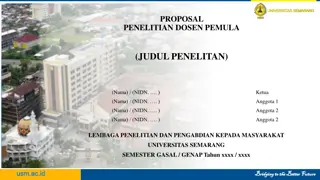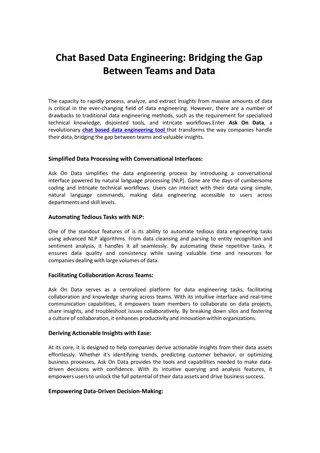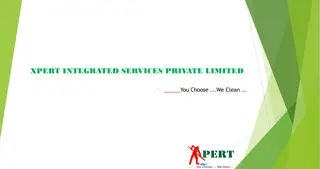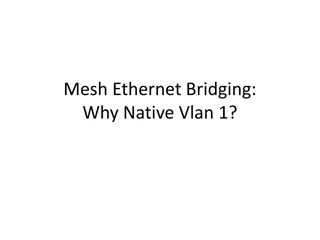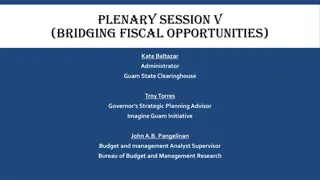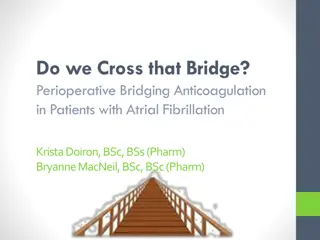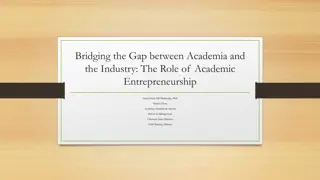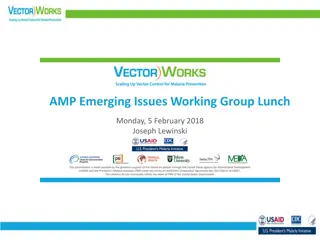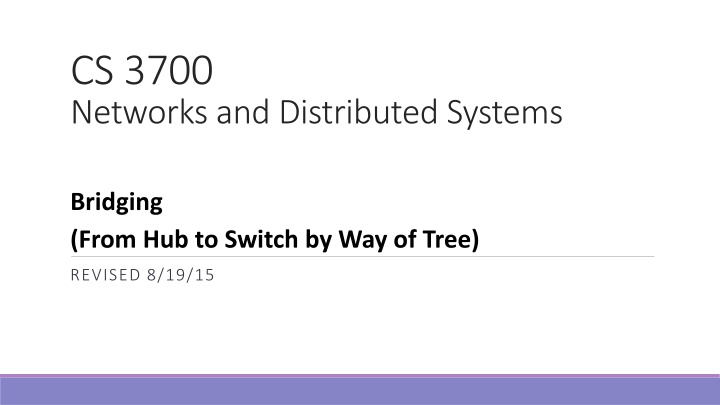
Connecting LANs: Bridging Networks and Distributed Systems
"Explore the concept of bridging in networks and distributed systems, from transitioning from hubs to switches to enhancing scalability and performance. Learn about the role of bridges, their internals, and the advantages they offer in connecting LANs seamlessly and efficiently."
Download Presentation

Please find below an Image/Link to download the presentation.
The content on the website is provided AS IS for your information and personal use only. It may not be sold, licensed, or shared on other websites without obtaining consent from the author. If you encounter any issues during the download, it is possible that the publisher has removed the file from their server.
You are allowed to download the files provided on this website for personal or commercial use, subject to the condition that they are used lawfully. All files are the property of their respective owners.
The content on the website is provided AS IS for your information and personal use only. It may not be sold, licensed, or shared on other websites without obtaining consent from the author.
E N D
Presentation Transcript
CS 3700 Networks and Distributed Systems Bridging (From Hub to Switch by Way of Tree) REVISED 8/19/15
Just Above the Data Link Layer Bridging How do we connect LANs? Application Presentation Function: Route packets between LANs Key challenges: Plug-and-play, self configuration How to resolve loops Session Transport Network Data Link Physical 2
Recap Originally, Ethernet was a broadcast technology Terminator Repeater Tee Connector Hub Pros: Simplicity Hardware is stupid and cheap Cons: No scalability More hosts = more collisions = pandemonium 3
The Case for Bridging Need a device that can bridge different LANs Only forward packets to intended recipients Much less broadcasting! A Send Packet B C Send Packet B C A Bridge Hub B B C C 4
Bridging the LANs Hub Hub Bridging limits the size of collision domains Vastly improves scalability Question: could the whole Internet be one bridging domain? Tradeoff: bridges are more complex than hubs Physical layer device vs. data link layer device Need memory buffers, packet processing hardware, routing tables 5
Bridge Internals Bridge Hub Inputs Outputs Switch Fabric Memory buffer Makes routing decisions Bridges have memory buffers to queue packets Bridge is intelligent, only forwards packets to the correct output Bridges are high performance, full N * line rate is possible 6
Bridges Original form of Ethernet switch 1. Forwarding of frames 2. Learning of (MAC) Addresses 3. Spanning Tree Algorithm (to handle loops) Connect multiple IEEE 802 LANs at layer 2 Goals Reduce the collision domain Complete transparency Plug-and-play, self-configuring No hardware of software changes on hosts/hubs Should not impact existing LAN operations Hub 7
Frame Forwarding Tables Each bridge maintains a forwarding table MAC Address Port Age 00:00:00:00:00:AA 1 1 minute 00:00:00:00:00:BB 2 7 minutes 00:00:00:00:00:CC 3 2 seconds 00:00:00:00:00:DD 1 3 minutes 8
Frame Forwarding in Action Port 1 Port 4 Port 2 Port 3 Assume a frame arrives on port 1 If the destination MAC address is in the forwarding table, send the frame on the correct output port If the destination MAC isn t in the forwarding table, broadcast the frame on all ports except 1 9
Learning Addresses Manual configuration is possible, but Time consuming Error Prone Not adaptable (hosts may get added or removed) Instead, learn addresses using a simple heuristic Look at the source of frames that arrive on each port Delete old entries after a timeout MAC Address Port Age 00:00:00:00:00:AA 1 0 minutes 00:00:00:00:00:AA 00:00:00:00:00:BB 2 0 minutes Port 1 Port 2 00:00:00:00:00:BB Hub 10
Complicated Learning Example <Src=AA, Dest=FF> Bridge 1 Bridge 2 <Src=CC, Dest=AA> AA 1 AA 1 CC 2 CC 1 <Src=EE, Dest=CC> EE 2 EE 2 Port 1 Port 2 Port 1 Port 2 Hub Hub Hub AA BB CC DD EE FF 11
The Danger of Loops <Src=AA, Dest=DD> CC DD This continues to infinity How do we stop this? Hub Remove loops from the topology Without physically unplugging cables Port 2 Port 2 802.1 uses an algorithm to build and maintain a spanning tree for routing AA AA AA 1 2 1 AA AA AA 1 2 1 Port 1 Port 1 Hub AA BB 12
Spanning Tree Definition A subset of edges in a graph that: Span all nodes Do not create any cycles This structure is a tree 5 1 1 2 2 3 3 4 6 2 3 5 5 1 4 4 7 6 6 7 7 13
Spanning Tree Poem Algorhyme I think that I shall never see a graph more lovely than a tree. A tree whose crucial property is loop-free connectivity. A tree that must be sure to span so packet can reach every LAN. First, the root must be selected. By ID, it is elected. Least-cost paths from root are traced. In the tree, these paths are placed. A mesh is made by folks like me, then bridges find a spanning tree. - Radia Perlman 14
802.1 Spanning Tree Approach 1. Elect a bridge to be the root of the tree 2. Every bridge finds shortest path to the root 3. Union of these paths becomes the spanning tree Bridges exchange Configuration Bridge Protocol Data Units (BPDUs) to build the tree Used to elect the root bridge Locate the next hop closest to the root, and its port Select ports to be included in the spanning trees 15
Definitions Bridge ID (BID) = <Random Number> Root Bridge: bridge with the lowest BID in the tree Path Cost: cost (in hops) from a transmitting bridge to the root Each port on a bridge has a unique Port ID Root Port: port that forwards to the root on each bridge Designated Bridge: the bridge on a LAN that provides the minimal cost path to the root The designated bridge on each LAN is unique 16
Determining the Root Initially, all hosts assume they are the root Bridges broadcast BPDUs: Root ID Path Cost to Root Bridge ID Based on received BPDUs, each switch chooses: A new root (smallest known Root ID) A new root port (what interface goes towards the root) A new designated bridge (who is the next hop to root) 17
Comparing BPDUs BPDU1 BPDU2 R1 Cost1 B1 R2 Cost2 B2 if R1 < R2: use BPDU1 else if R1 == R2 and Cost1 < Cost2: use BPDU1 else if R1 == R2 and Cost1 == Cost 2 and B1 < B2: use BPDU1 else: use BPDU2 18
Spanning Tree Construction 3: 3/0 3: 0/2 0: 0/0 12: 12/0 12: 0/1 41: 41/0 41: 3/1 41: 0/2 27: 27/0 27: 0/1 68: 68/0 68: 9/1 68: 3/2 68: 0/3 9: 9/0 9: 3/2 9: 0/3 19
Designated Bridges Ultimately, each bridge must decide to enable or disable each port ? On, A Reasons to keep a port enabled: A. You receive no BPDUs on that port Indicates there are no other bridges B. The port is a root port You need to be able to forward packets to the root of the spanning tree C. You are the designated bridge for that LAN All other bridges on that LAN have a longer path to the root, or their bridge ID is higher than yours ? On, C ? On, C 0 ? 9 27 On, B ? On, B ? ? Off On, C 20
More Designated Bridges Ultimately, each bridge must decide to enable or disable each port ? On, C ? On, C Reasons to keep a port enabled: A. You receive no BPDUs on that port Indicates there are no other bridges B. It is the root port You need to be able to forward packets to the root of the spanning tree C. You are the designated bridge for that LAN All other bridges on that LAN have a longer path to the root, or their bridge ID is higher than yours 0 ? 9 27 On, B ? On, B ? On, C ? On, C ? ? Off On, B 3 21
Bridges vs. Switches Bridges make it possible to increase LAN capacity Reduces the amount of broadcast packets No loops 2 hosts on 1 port Switch is a special case of a bridge Each port is connected to a single host Either a client machine Or another switch Thus, there are no collision domains No need for CSMA/CD! Simplifies hardware. Can have different speeds on each port Not a legal network with switches 22
Switching the Internet Capabilities of switches: Network-wide routing based on MAC addresses Learn routes to new hosts automatically Resolve loops Could the whole Internet be one switching domain? NO 23
Limitations of MAC Routing Inefficient Flooding packets to locate unknown hosts Poor Performance Spanning tree does not balance load Hot spots Extremely Poor Scalability Every switch needs every MAC address on the Internet in its routing table! IP addresses these problems (next lecture ) 24

